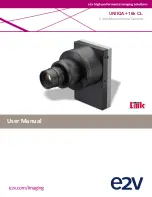
BOBCAT Hardware User’s Manual
Imperx, Inc.
Rev. 2.0.6
6421 Congress Ave.
11/20/2012
Boca Raton, FL 33487
+1 (561) 989-0006
62 of 265
1.5.2 Optical
The smaller body BOBCAT cameras (45 x 45) mm cross-section come with an
adapter for C-mount lenses, which have a 17.52 mm back focal distance – Figure
1.9a and Figure 1.9b. An F-mount lens can be used with a C-mount camera via an F-
mount to C-mount adapter, which can be purchased separately – refer to the Imperx
web site for more information. The bigger body BOBCAT cameras (60 x 60) mm
cross-section come with an adapter for F-mount lenses, which have a 46.50 mm back
focal distance – Figure 1.9c. The camera performance and signal to noise ratio
depends on the illumination (amount of light) reaching the sensor and the exposure
time. Always try to balance these two factors. Unnecessarily long exposure will
increase the amount of noise and thus decrease the signal to noise ratio.
The cameras are very sensitive in the IR spectral region. All color cameras have and
IR cut-off filter installed. The monochrome cameras are without IR filter. If
necessary, an IR filter (1 mm thickness or less) can be inserted under the front lens
bezel.
CAUTION NOTE
1.
Avoid direct exposure to a high intensity light source (such as a laser beam).
This may damage the camera optical sensor!
2.
Avoid foreign particles on the surface of the imager.
1.5.3 Environmental
The camera is designed to operate from -30
0
to 60
0
C in a dry environment. The
relative humidity should not exceed 80% non-condensing. Always keep the camera
as cool as possible. Always allow sufficient time for temperature equalization, if the
camera was kept below 0
0
C!
The camera should be stored in a dry environment with the temperature ranging
from -50
0
to + 70
0
C.
CAUTION NOTE
1.
Avoid direct exposure to moisture and liquids. The camera housing is not
hermetically sealed and any exposure to liquids may damage the camera
electronics!
2.
Avoid operating in an environment without any air circulation, in close
proximity to an intensive heat source, strong magnetic or electric fields.
3.
Avoid touching or cleaning the front surface of the optical sensor. If the sensor
needs to be cleaned, use soft lint free cloth and an optical cleaning fluid. Do not
use methylated alcohol!
















































